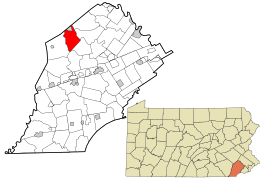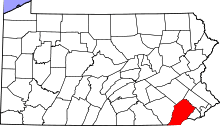West Nantmeal Township, Chester County, Pennsylvania
| West Nantmeal Township | |
|---|---|
| Township | |
|
Pleasant Hill Plantation, a historic site in the township | |
 Location in Chester County and the state of Pennsylvania. | |
.svg.png) Location of Pennsylvania in the United States | |
| Coordinates: 40°07′27″N 75°48′55″W / 40.12417°N 75.81528°WCoordinates: 40°07′27″N 75°48′55″W / 40.12417°N 75.81528°W | |
| Country | United States |
| State | Pennsylvania |
| County | Chester |
| Area[1] | |
| • Total | 13.54 sq mi (35.07 km2) |
| • Land | 13.33 sq mi (34.52 km2) |
| • Water | 0.21 sq mi (0.55 km2) |
| Elevation | 686 ft (209 m) |
| Population (2010) | |
| • Total | 2,170 |
| • Estimate (2016)[2] | 2,192 |
| • Density | 164.44/sq mi (63.49/km2) |
| Time zone | UTC-5 (EST) |
| • Summer (DST) | UTC-4 (EDT) |
| Area code(s) | 610 |
| FIPS code | 42-029-83664 |
West Nantmeal Township is a township in Chester County, Pennsylvania, United States. The population was 2,170 at the 2010 census. It and East Nantmeal Township were originally part of a single Nantmeal Township, which was divided in 1739.
History
Nantmeal was named by Welsh immigrants from the village of Nantmel in Radnorshire, now part of Powys. The Welsh name, Nantmel, means 'the valley of Mael', a tenth-century prince. The incorrect belief that it means 'Honey Brook' is based on a confusion between the personal name 'Mael', and the Welsh word 'mêl', 'honey'. The Isabella Furnace and Pleasant Hill Plantation are listed on the National Register of Historic Places.[3]
Geography
According to the United States Census Bureau, the township has a total area of 13.5 square miles (35 km2), of which 13.4 square miles (35 km2) is land and 0.1 square miles (0.26 km2), or 0.45%, is water. The township is partially located in the Hopewell Big Woods.
Demographics
| Historical population | |||
|---|---|---|---|
| Census | Pop. | %± | |
| 1930 | 624 | — | |
| 1940 | 565 | −9.5% | |
| 1950 | 806 | 42.7% | |
| 1960 | 968 | 20.1% | |
| 1970 | 1,285 | 32.7% | |
| 1980 | 1,766 | 37.4% | |
| 1990 | 1,958 | 10.9% | |
| 2000 | 2,031 | 3.7% | |
| 2010 | 2,170 | 6.8% | |
| Est. 2016 | 2,192 | [2] | 1.0% |
| [4] | |||
At the 2010 census, the township was 94.4% non-Hispanic White, 1.1% Black or African American, 0.3% Native American, 0.6% Asian, 0.1% Native Hawaiian or other Pacific Islander, and 1.1% were two or more races. 2.3% of the population were of Hispanic or Latino ancestry.[5]
As of the census[6] of 2000, there were 2,031 people, 715 households, and 566 families residing in the township. The population density was 151.4 people per square mile (58.4/km²). There were 745 housing units at an average density of 55.5/sq mi (21.4/km²). The racial makeup of the township was 97.54% White, 0.74% African American, 0.30% Asian, 0.25% from other races, and 1.18% from two or more races. Hispanic or Latino of any race were 0.84% of the population.
There were 715 households, out of which 36.1% had children under the age of 18 living with them, 71.3% were married couples living together, 4.6% had a female householder with no husband present, and 20.8% were non-families. 19.0% of all households were made up of individuals, and 8.7% had someone living alone who was 65 years of age or older. The average household size was 2.84 and the average family size was 3.24.
In the township the population was spread out, with 27.6% under the age of 18, 5.7% from 18 to 24, 27.6% from 25 to 44, 26.5% from 45 to 64, and 12.5% who were 65 years of age or older. The median age was 39 years. For every 100 females there were 104.3 males. For every 100 females age 18 and over, there were 101.6 males.
The median income for a household in the township was $52,128, and the median income for a family was $55,776. Males had a median income of $40,938 versus $29,813 for females. The per capita income for the township was $21,348. About 2.5% of families and 4.4% of the population were below the poverty line, including 6.8% of those under age 18 and 3.1% of those age 65 or over.
Notable residents
- George Lippard (1822–1854), the 19th-century American novelist, journalist, and playwright, was born in 1822 in West Nantmeal Township on the farm of his father, Daniel B. Lippard. Two years later the family moved to Philadelphia after his father was injured in a farming accident. During the decade between 1844 and 1854 he was among the most widely read authors in the United States. He befriended Edgar Allan Poe and advocated a socialist political philosophy, becoming an unheralded writer for the proletariat. Even young Mark Twain expressed admiration for his historical fiction stories known as "legends".
References
- ↑ "2016 U.S. Gazetteer Files". United States Census Bureau. Retrieved Aug 13, 2017.
- 1 2 "Population and Housing Unit Estimates". Retrieved June 9, 2017.
- ↑ National Park Service (2010-07-09). "National Register Information System". National Register of Historic Places. National Park Service.
- ↑ http://www.dvrpc.org/data/databull/rdb/db82/appedixa.xls
- ↑ https://www.usatoday.com/news/nation/census/profile/PA
- ↑ "American FactFinder". United States Census Bureau. Retrieved 2008-01-31.
